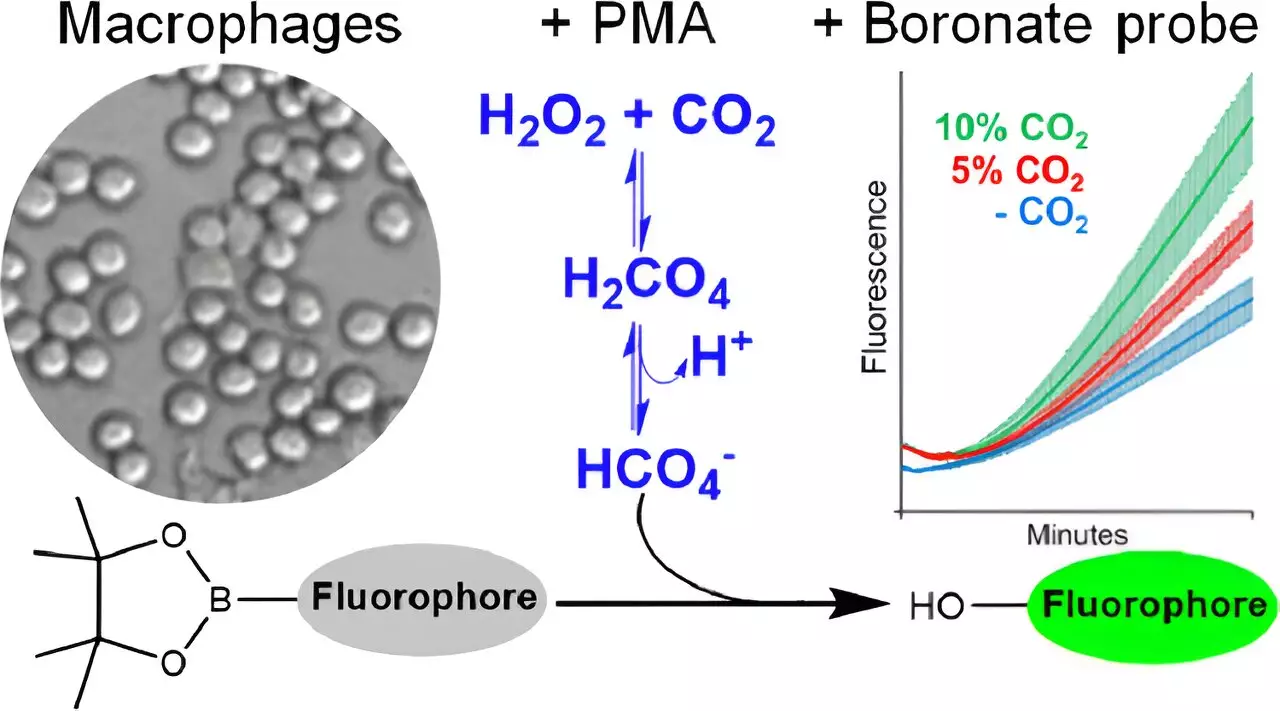As the concentration of carbon dioxide (CO2) in the atmosphere continues to soar due to human activities, the resulting implications extend beyond climate change; they challenge the very fabric of cellular biology. The intricacies of how elevated CO2 affects biological systems are becoming increasingly critical to our understanding of human health. Recent research spearheaded by Ohara Augusto from the University of São Paulo highlights a fascinating interaction between CO2 and hydrogen peroxide (H2O2) that gives rise to a previously underappreciated oxidant: peroxymonocarbonate. This new discovery sheds light on both adaptive cellular responses and potential dysfunctions attributable to oxidative stress in environments with elevated CO2 levels.
Peroxymonocarbonate—a chemical compound long familiar to chemists but previously unseen in biological cells—has gained traction as a significant player in cellular mechanisms due to Augusto’s groundbreaking research. Published in the journal *Chemical Research in Toxicology*, the study introduces an innovative methodology for detecting this oxidant within cellular environments, promising to enhance our grasp on the oxidative processes occurring in the body. The investigators utilized fluorescent molecular probes to ascertain the presence of peroxymonocarbonate in macrophages, immune cells known for their ability to respond dynamically to varying oxidative states.
Through this novel approach, researchers discovered that when macrophages were activated and exposed to both CO2 and H2O2, peroxymonocarbonate was produced. This crucial finding alters the discourse surrounding oxidative stress, suggesting that some previously observed cellular responses might not stem solely from hydrogen peroxide as assumed but could also be influenced by the presence of peroxymonocarbonate.
Ohara Augusto elucidated that CO2 serves not only as a precursor for peroxymonocarbonate but also modulates the reactivity of hydrogen peroxide and peroxynitrite. This poses an intriguing notion; CO2 is no longer merely a byproduct of respiration—it is implicated in the intricate signaling that governs cellular responses to oxidative stress. For instance, when cells experience slight increases in stress, they adapt by generating oxidants that can activate certain genes associated with protective mechanisms, such as the expression of antioxidant enzymes.
Interestingly, peroxymonocarbonate is noted to oxidize thiol proteins faster than hydrogen peroxide, implying its potential role as a rapid signaling molecule within the cell. This dynamic interaction signifies a paradigm shift, prompting scientists to reconsider established notions of redox biology and the pathways through which cells communicate and respond to their microenvironments. The notion that peroxymonocarbonate could play a role in such adaptations paves the way for further exploration into the cellular mechanisms of stress response and metabolic resilience.
While the promising insights derived from the study elucidate the role of peroxymonocarbonate, it simultaneously raises concerns about the physiological implications of prolonged exposure to elevated CO2 levels. Epidemiological data indicate that rising CO2 concentrations in urban environments correlate with various health issues, yet the specifics of the underlying mechanisms remain largely enigmatic. The research conducted by Augusto propels the hypothesis that peroxymonocarbonate might be one of the intermediaries through which CO2 exerts its biological toxicity.
As scientists push the boundaries of existing knowledge, it becomes critical to investigate the cascading effects of CO2 on cellular function and the associated onset of various ailments. Such research could predict potential public health ramifications as global emissions continue to escalate. Understanding the identity and function of peroxymonocarbonate may provide insights that lead to therapeutic strategies aimed at mitigating oxidative damage linked to environmental stressors.
The intersection of climate change and cellular biology opens up a complex and urgent field of study. The detection and analysis of peroxymonocarbonate in cellular systems illuminate a pathway for understanding how elevated CO2 concentrations can manifest in biological consequences. While previous studies have predominantly focused on hydrogen peroxide and classical oxidants, the emergence of peroxymonocarbonate challenges researchers to broaden their scope and reconsider the implications of atmospheric shifts on human health.
Future investigations into this newly identified oxidant and its effects under varying environmental conditions are necessary to comprehensively understand both adaptive cellular responses and potential dysfunctions. As we stand at this crossroads of environmental science and cellular biology, the importance of interdisciplinary research cannot be overstated. It ultimately holds the key to unlocking solutions that will protect both our planet and our health in the face of escalating CO2 levels.


Leave a Reply